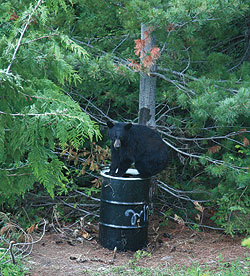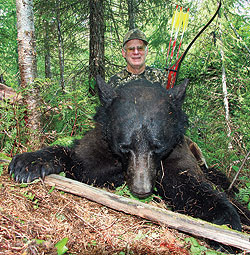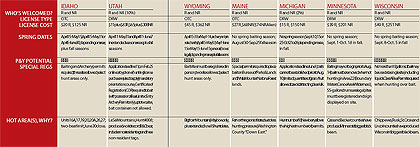October 28, 2010
By Patrick Meitin
A do-it-yourself guide to scoring black bears over bait.
By Patrick Meitin
 Baiting serves as an effective management tool, as unlike spot-and-stalk or still-hunting, there's plenty of time for the hunter to look over his bruin and make a more accurate assessment of size and age, striving to take only mature boars. |
Bowhunters love a good argument. Be it mechanical vs. fixed-blade broadheads, traditional bows vs. compounds or vertical bows vs. crossbows, I've found that those who yell loudest typically prove, under closer scrutiny, least acquainted with the issue at hand. So it often is with bowhunting black bears over bait; even certain die-hard archers labeling it an unsportsmanlike pursuit.
Yet success even on fully-guided bait hunts, so seemingly devoid of required skill and effort to the uninitiated, comes at a price well beyond obvious hunt fees. If you've been there, you understand absolutely and I needn't explain further. If you haven't, carp to me only after you've given it a fair shake.
Advertisement
When it comes to bear baiting without professional assistance, well, that's a different animal altogether. Only when you've done it yourself can you totally understand the backbreaking, time consuming preparation and solid woodcraft skills needed to achieve success.
Advertisement
Site Selection
Obviously, you must reside in or travel to a state that still allows bear baiting to find such success. Canadian citizens and Alaska residents have it easy. The rest of us are restricted to limited Western and far northern Midwest or Northeastern states to enjoy opportunities for self-guided, baited hunts. While a few Western states allow spring hunting, Eastern bowhunters must work within more demanding fall dates.
Black bears certainly traipse populated areas, tipping garbage pails and frequenting landfills in search of an easy meal, but more agreeable baiting experiences point to desolation. Avoiding popular hiking trails, campgrounds and fishing areas minimizes non-hunting or even anti-hunting intrusion, which could threaten future of bear baiting in your chosen area.
A secreted spot is preferable for those reasons alone, but it also assures uninterrupted hunts, especially where hound hunting also is legal. Nothing's more frustrating than working hard to create a hot site only to have bears harassed by houndsmen plying a legal trade. Seek areas where difficult access deters competition. And arrive willing to schlep bait far from roads or ATV trails. Thoroughly acquaint yourself with your area, making sure road loops or trails don't create unexpected flanking access. An ATV can come in extremely handy, allowing use (where legal) of defunct logging roads inaccessible by even rugged SUVs.
Fine Tuning
The rest of the process is all intensive scouting. Seek bear tracks and droppings along ridges, game trails or at water. This will help discern population densities and trophy quality. Front pads from 4-4€‰1„2 inches wide reveal an average bear; 5 inches or better is a bruiser.
 This is the kind of boar every serious bear hunter dreams about. Pat Keith's behemoth scored around 20 inches, two inches larger than the Pope and Young Club's 18-inch minimum. He took the boar while sitting one of author Patrick Meitin's Idaho baits. |
The best locations generally involve a healthy combination of thick escape cover and water. Remember, it's more important to find sites where scent is easily controlled than simply placing bait right on a bear's accustomed path. Bears have unsurpassed noses. They'll find your bait given time. With time on your side, you can remain nitpicky about site placement. With limited time, you must be certain your bait will be discovered nearly immediately. Re-use of a bait site productively employed last season is a great choice, as bears seem to make these places a regular part of their rounds.
Bruins' olfactory senses rival even that of whitetail. Don't believe human scent you leave while setting up and working baits desensitizes your quarry, as they have an uncanny ability to sniff out intruders. Although scent-containment clothing and sprays can help, depend on topography and prevailing winds to safely carry scent away from your site. In most mountain terrain, wind is as honest as a newborn -- running steadily downhill -- during the productive late afternoon and evening hours when most bruins are arrowed.
Ideally, look for sites with steep points or edges and place baits on a flat bench or ledge, with your stand on a severe drop where breezes are carried into open space well above the ground below. This also places you, even if 35 feet up a tree, on the level with your target for better shot angles. Avoid saddles or bottoms where breezes can prove aimless.
There's no need to hang stands right away. Give bears time (when available) to fall into a pattern and establish telltale trails. After bait is hit with regularity, approach routes become wholly obvious, providing educated insight into stand placement in direct relation to scent management.
Feeding Success
Spring bears are almost literally starving and looking to put on weight lost during long winter hibernation. In the interests of budgetary concerns (you're normally facing a hefty fuel bill while working baits, after all), some creativity is in order to keep bears coming back. Bears have an uncontrollable sweet tooth but will snarf up anything that helps pack on pounds.
Cheap dog kibble is affordable filler that bears happily devour, especially when sprinkled liberally with used fry grease (begged from gas-station delis or fast-food joints) and/or molasses. Day-old bakery goods are an obvious staple, especially sugary donuts bought cheaply from bakery outlet stores. I'm not above midnight dumpster diving; gathering discarded fried chicken, pizza and such from trash receptacles behind restaurants. I've also managed to score meat scraps and expired fruit from grocers. During fall, gathering unwanted apples from roadside trees provides plenty of free bait bears relish.
Spring bowfishing is an excellent way to jumpstart bait sites. Carp and/or suckers (check regulations to assure legality) aged in a hot sun create a powerful stink, drawing crows and ravens that pull bears from miles. Tossed in the freezer and served fresh, many bears eat them outright. In northern latitudes, befriend a trapper, coaxing him to save beaver carcasses throughout winter months. Bears everywhere love beaver meat. Aromatic oils such as anise, cinnamon and vanilla, for instance, can also perk bears' interest. Pour these over punky stumps or logs,
which helps hold scent longer.
 To enlarge this image, please click here. |
How you distribute bait depends on available time and how often you'll visit your site. When camped on site, making a single expedition of it, piling bait in a log crib or against a stump to help position bears for viable shots is effective. Stack sizable logs atop bait to deter crows and ravens, soaking these with grease or molasses to keep bears busy should they find the bait exhausted.
I prefer 55-gallon barrels with removable (but secure) lids. Cutting an eight-inch circle in the lid forces bears to fish for food and slows consumption a tad. Through a bottom corner, cut holes and attach six feet of stout 3„8-inch steel cable, securing a loop with clamps.
Create another loop on the opposite end and add a carabineer clip. This allows securing the barrel to a tree or stout root to keep it from disappearing into the bush and anchors feeding bears within range. More importantly, a large, secured barrel requires less frequent visits, keeping hungry bears satisfied while you work to earn your weekend getaway. Still, that's no guarantee. With my most productive Idaho sites, hungry bears empty brimming-full barrels every three days. It's also important to read regulations carefully, as some states dictate what can be used to contain bait and even how big it can be.
In better habitats, it's not uncommon to have baits hit the very night they're placed. But generally, the longer they sit, the better they produce. Placing your bait as early as legally permissible is a boon, even if your schedule doesn't allow you to bowhunt right away.
Late May is the prime spring time for both action and prime pelts, though June breeding seasons typically bring the biggest boars out of the woodwork. Understand, however, you're walking a fine line between waiting for a behemoth and risking rubbed hides that late. Fall can make baiting more hit and miss, especially when natural foods are readily available. Still, you can expect action simply because bruins are gorging greedily for winter hibernation and seldom pass up a free meal.
If you've read this far, you've likely come to understand baiting bears on your own is a huge commitment in time and hard work. While even the fully-outfitted bear hunt is an exciting and exotic adventure, baiting your own bears comes with a higher sense of accomplishment and pride. It's not for everyone, to be sure; but for me, it's just about as rewarding and exciting as bowhunting North America gets.
